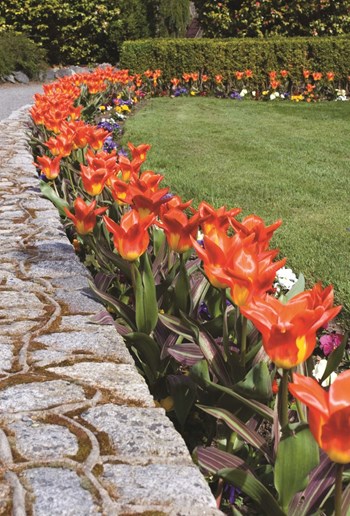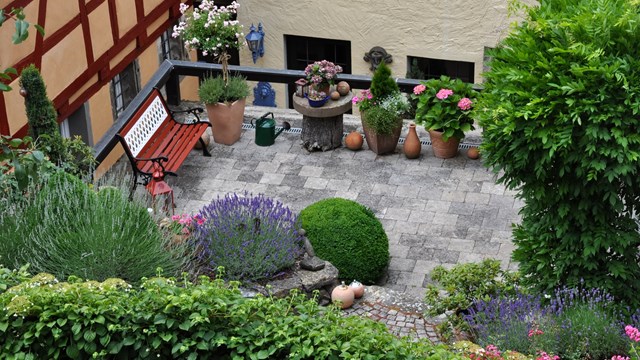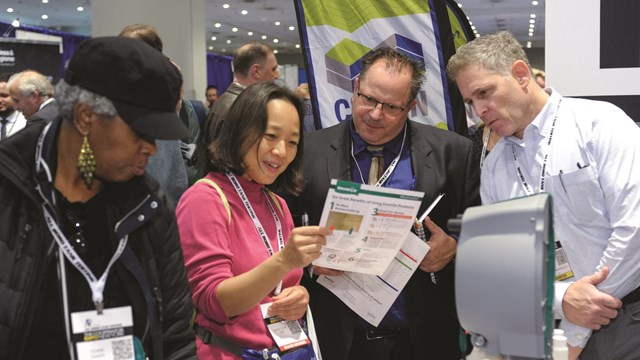
Here comes spring, and it might be nice to improve the look of things around your association’s grounds with some new flowers, shrubs, or trees. With the dizzying array of plants to choose from, selecting the right ones can be a daunting challenge, and a visit to the local nursery can leave you with more questions than answers. Before you go, it’s a good idea to sort through the various options: perennial or annual, deciduous or evergreen, high maintenance or low maintenance, early bloom or late bloom… these are just a few of the factors to be considered.
First Things First
Location: it’s the classic real estate consideration, and it applies to plants, too. Making sure that plants are selected for the right hardiness zone (New Jersey ranges from zone 5 in the mountains to zone 7 on the coastline) can go a very long way in assuring that the plants that you plant don’t just survive, but thrive.
“You have to take into consideration what will grow where,” says Barry Yacker, a certified landscape architect with Livingston-based DuBrow’s Nurseries, Inc.
This applies to both conditions, urban and suburban, adds Richard Heller of Greener By Design, Inc. in Pelham, New York. “In an urban setting, buildings create microclimates all over the place. They shield the wind, the light, and the temperature. Any plantings that are done over a building, a green roof, or a garden that is above a basement or garage will have subterranean heating. That means that plants may come out of dormancy early, and that the site will not experience the same climatic conditions as an nearby site that is in the ground.”
“In the city you have the heat island effect,” adds Marechal Brown, director of horticulture in District 12 of the New York Parks Department, “which basically means that the buildings and road surfaces retain more heat and drier conditions for plants.”
“There are three factors that most influence plants: light, soil, and moisture,” continues Heller. “Historically, a layer of compost served the purpose of creating food for plants. They can’t just absorb nutrients from the air and the soil. They need the microorganisms and bacteria that are present in the top layer of soil called humus.”
Even though that sounds like the job of fertilizer, feeding plants has its own considerations, and spraying Miracle-Gro all over place may not be the answer. “After World War II, developments in bomb-making, strangely enough, made chemical fertilizers possible,” says Heller. “This saved countless hours of man power, since we no longer needed to compost and spread the material over the soil to prepare it for optimal plant growth, but it also created a new set of problems. In fact, most of the excess nitrogen (the primary ingredient in most plant food) that is applied is not from industrial use; it’s from private sources that are applying too much fertilizer.
Depending on the condition of the soil around your community grounds, you may need to do a little more than just dig holes and put plants in the ground. “Suburban native topsoil is often scraped to build a house,” says Brown. “In the city, little or no native soil is left, except in parks, where it has been built up from scratch.”
Animals and Pests
“One of the biggest concerns in New Jersey is the deer,” says Yacker. “They eat everything now, and it’s really become a problem. In the suburbs and rural areas, you have to use plants that are thorny or bad tasting like juniper or boxwood. Deer like things like blue holly and yew.”
Hunting is not the only way to control deer, continues Yacker. “We usually recommend that people get on a spray program that will help deter the deer, and we usually recommend planting things like spyrea and sometimes azaleas, although the deer will eat those too.”
The spray program comes in lots of varieties, says Yacker, and can be used in combinations that will help control insects, fungi, and other potential pests as well as deer. “The natural ones have mint or other flavors or scents that will deter the deer from their path,” he says. “Once you change their path, they will keep taking another path to find their food.”
Being eaten and being trampled have roughly the same effect on most plants, and in multi-family developments, people can be detrimental to the health of plants as well. “If you have a high traffic area, and you want to keep people out, you can use a thorny shrub like barberry or something that will keep them away from the area,” says Yacker, “just like the deer. You can use a nice-looking plant that has a needle or something that will make people not want to go through it.”
Aesthetic Considerations
“For most townhome complexes, you want to use something that is easily maintained and hardy,” explains Yacker. “We also try to design so that there is some color at different times during the year.”
Yacker recommends a couple of guidelines for choosing plants in suburban areas: Plant evergreens like boxwoods or junipers on the foundations, so that when the deciduous plants lose their leaves you still have some green color all through the year. Also, choose plantings so that there are layers—hedges in the back and then flowering shrubs like spyrea, azaleas, and deutzias, and then the perennials that will give you a lot of color. You can also use shrubs to block headlights from flooding front-facing apartments with glaring light at night.
For a more upscale look, consider planting weeping varieties of cherries or pines. “Weeping plants give a little more ornate, or upscale feeling,” says Yacker. “They are different, and people like them because you don’t see them everywhere. Blue Atlas cedar is also a beautiful, more stately plant, not your typical sight.”
For a more inviting and relaxed feeling, consider plants that are not geometrically placed around the site, or have a tendency to grow in a more haphazard fashion, says Brown. “A looser growth habit usually translates as more ‘casual.’”
“A lot of people are tempted to use pines,” says Heller, “but when they grow for a couple of years and reach a certain height, they begin to lose their lower limbs, which makes them unsuitable for privacy screening. Spruces are a better choice because they keep their limbs.”
“Things like the Colorado spruce provide utilitarian functions like screening,” adds Yacker. “Douglas firs also don’t lose their bottoms like white pines, which grow very vast.”
Also, “Ornamental grasses are great choices [for screening] because the deer don’t bother them as much and they give you a year-round effect,” Yacker says. “They come up green or variegated, they are wispy, they flow with the wind, they get a plume on them in the fall, and in the winter time you can cut them down or leave them up. They’ll keep their shape, and just brown out, making it a very effective plant.”
Most people expect some grass around a house, and a lush lawn is emblematic of a comfortable suburban home. Choosing a grass seed and planting type can have a big impact on the quality of a yard, says Yacker. “A lawn is going to grow, so you will have to cut it, but most people don’t know that a seeded lawn will grow stronger than a sodded lawn, because seeds grow from the soil, where the sod is essentially a transplant. The sod is immediate, whereas the seeded lawn needs a couple of years of reseeding or maintenance to come in fully.”
Other Considerations
One of the main concerns for multi-family developments is the maintenance and care required to keep plants looking their best. Few things evoke decay more than a browned-out evergreen, or a wildly overgrown flowerbed full of weeds and lopsided shrubs.
“Native plants often require the least maintenance, because they are better adapted to local growing conditions,” explains Brown. “Look for where a plant comes from natively—not where it is grown in a nursery—and you can learn more about its maintenance. Sweet Fern grows in sandy soil in New Jersey and Long Island, for example. Rhododendrons are from woodland understories, as are dogwoods and birches, which often get misplaced in the middle of suburban lawns in hot sun. Daffodils won’t grow in Florida—they come from a colder winter climate, and so forth.” Also, be aware of the surrounding landscape, and not just the limits of the development site, says Heller. “If you have a body of water near the site where chemical fertilizers are used, there should be a buffer layer of trees or other plants between the site and the body of water. Not only will the chemical fertilizer run into the water and upset the nutrient balance, but the soil itself will find its way to the river, lake, or stream, and muddy up the water.”
Think with the future in mind, advises Heller. “When you design a planting you have to remember that it is going to grow. You have to ask yourself, how is this going to look in 10 years? Make sure that you haven’t planted shrubs that will grow too tall or a tree in front of a window, for example. One common mistake people make is planting things too close to the building or too far away.”
With all the things to consider when choosing plants for your property, it might be a good idea to consult a specialist. A nursery employee will be able to give some good direction, but someone designing for your site may be the best way to go. “We spend extensive time with each customer,” says Yacker, “learning what they want from the property, and we develop and design a full scale or plan to realize their vision.
Denton Tarver is a freelance writer and landscape architecture student living in New York City.





Leave a Comment